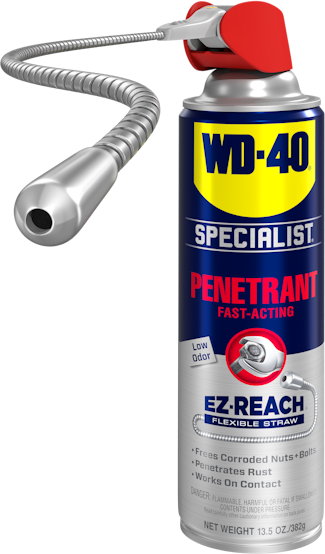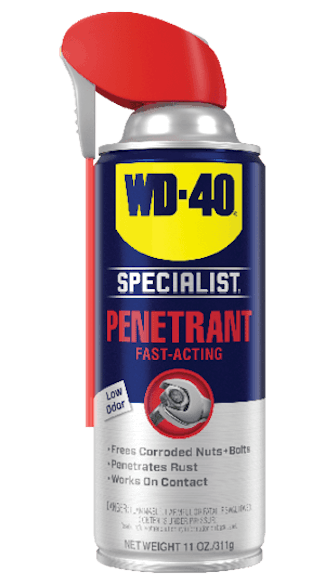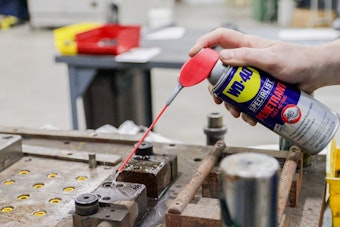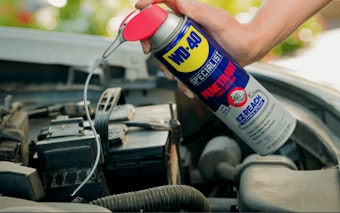How Penetrating Oil Works: The Science Behind the Spray
How Penetrating Oil Works: The Science Behind the Spray
<< BackArchimedes once said:
“Give me a lever long enough and a fulcrum on which to place it, and I shall move the world.”
His time, however, was a time without penetrating oil… which could have significantly shortened the required lever.
Penetrating oil, also commonly known as a penetrant, is a low-viscosity oil used to loosen rusted mechanical parts such as nuts or bolts.
Understanding Penetrant
Penetrating oil is designed to break down the rust that causes metal parts to stick or seize together while providing temporary lubrication. This oil is characterized by low viscosity, a measure of how easily a fluid flows. This low viscosity allows it to flow into narrow crevices and threads that standard oils simply cannot reach. Unlike other products, which may have formulas that are too thick and have maximum adherence to surfaces, this oil can penetrate the tight spaces between two parts, break down any rust present, and free them.
The ability to free stuck metal parts makes penetrating oil a valuable addition in any industry including automotive repair, industrial operations and maritime.
The Science Behind Penetrants
The ability of penetrants to free stuck metal parts is ascribed to their formulation. They commonly consist of four compounds:
Solvents
Solvents serve to reduce the viscosity of penetrating oil, allowing the oil to easily flow into narrow crevices. They also aid in breaking down the rust that causes the parts to be stuck. Typical solvents include acetone, mineral spirits and kerosene.
Reactants
Reactants break down the rust formed between the parts. Common reactants include chelating agents such as ethylenediaminetetraacetic acid (EDTA), and citric or phosphoric acid.
Lubricants
Lubricants form the base of a penetrating oil. They can range from petroleum to synthetic oils and even lanolin, an oil derived from sheep’s wool. Lubricants reduce the coefficient of friction between the stuck parts, providing the necessary slickness to allow their movement.
Additives
Additives range in type depending on the added functionality required for the oil. One of the most common additives contained in these oils is rust inhibitors such as zinc dialkyldithiophosphate (ZDDP) and benzotriazole.
Following the summary of the common compounds found in this modern marvel, the question becomes, how does it work?
Capillary action is the scientific phenomenon driving the penetration ability of these oils. It is the process of a liquid flowing into a narrow space without the assistance of any external forces.
Once the oil has entered the crevice between the stuck parts, thanks to capillary action, the solvents and reactants contained within it take over.
The solvents and reactants work to break down the rust that causes the parts to stick together. Once the rust has been broken down, the oil base serves as a lubricant to reduce friction between the parts. The friction is lowered to such a point that through some mechanical agitation, the parts can be freed from one another. Any additives contained in the penetrant can now get to work, inhibiting any further rust from being formed and ensuring that the parts remain unstuck.
Application Techniques for Rust Penetrating Spray
Now that we have a better grasp on what penetrating oils are and how they work, it becomes important to understand how to apply this rust penetrating spray.
Let’s use rusted bolts as an example to help explain the application process. Note that even though the example is based on rusted bolts, the same methodology can be followed for any stuck metal part.
To get started, grab a can of our WD-40 Specialist® Penetrant, personal protective equipment (PPE) including gloves and eye protection, and depending on the type of bolt that is stuck, either a wrench or socket. As always, ensure to follow the safety guidelines provided by the manufacturer.
A step-by-step guide follows below.
- Move to a Well-Ventilated Area: In the words of any property professional, ever, “Location, location, location”. Ensure that you are working in a well-ventilated area and that you are not near any open flames.
- Wear the Appropriate PPE: Always dress to impress, this is especially important when it comes to your safety. The next step when applying a penetrant is to wear the appropriate PPE such as safety goggles, gloves and any other PPE suggested by the manufacturer.
- Clean the Surface: Remove any dirt or debris around the stuck bolt to ensure that the oil can work efficiently.
- Apply the Oil: Spray the penetrant directly onto the surface of the stuck bolt. The WD-40 Specialist® Penetrant comes with our signature Smart Straw® Sprays 2 Ways® applicator. This nozzle allows you to spray with a pinpoint stream or, when the straw is folded down, a wide-angle spray. Ensure to saturate the surface of the stuck bolt. For hard to reach bolts, the WD-40 Specialist Penetrant with EZ-Reach flexible straw is ideal.
- Let it Soak: Allow the oil to sit and penetrate the narrow crevices around the bolt for several minutes.
- Attempt to Loosen: Using the appropriate wrench or socket, attempt to loosen the bolt.
- Re-Apply if Required: If the bolt is still stuck, reapply the penetrating oil and repeat the soaking and loosening process.
- Viola! After following steps 1 to 7, you should now no longer have a stuck bolt.
To get the best results, always apply the penetrant generously to ensure full coverage. Patience is key when applying. Reapplication may also be necessary depending on the amount of rust present.
Benefits of Using Penetrating Oil
Penetrating oil will not only release pesky rusted bolts – there are many more short- and long-term benefits of using penetrants.
The first benefit of using a penetrant is saving time and effort. When using a penetrant, you are able to remove stuck bolts and parts faster with little effort needed, speeding up day-to-day maintenance tasks. What’s more, when using a penetrant you are able to continue working on other tasks while the oil penetrates the stuck part. In addition, this time-savvy product reduces the need for excessive force, mitigating any potential damage to bolts, parts, tools, or muscles.
Another benefit associated with the use of penetrating oil is the prevention of rust formation, holding long-term benefits for machinery and tools. The corrosion inhibitors help to prevent any rust from further forming, extending the life of tools and machinery. Because of this, we recommend using penetrating oil as part of your regular maintenance routine. This will proactively protect your machinery and tools, ensuring they remain in good working condition.
The final benefit we must emphasize is penetrating oil’s versatility. Use it to maintain machinery in industrial environments. This includes using it to remove rust from important pieces of equipment or to loosen screws, nuts, fasteners and stuck locks.
We will never bad-mouth Archimedes, but all we are saying is that after learning more about penetrating oil, that lever would have definitely been too long.
If you are looking for a powerful penetrant that can be used in auto shops to manufacturing facilities, WD-40 Specialist® Penetrant is the way to go.
Be sure to check out all of our products from our WD-40 Specialist line.
FEATURED PRODUCTS
WANT TO GET MORE TIPS AND TRICKS?
SUBSCRIBE TO THE NEWSLETTER



